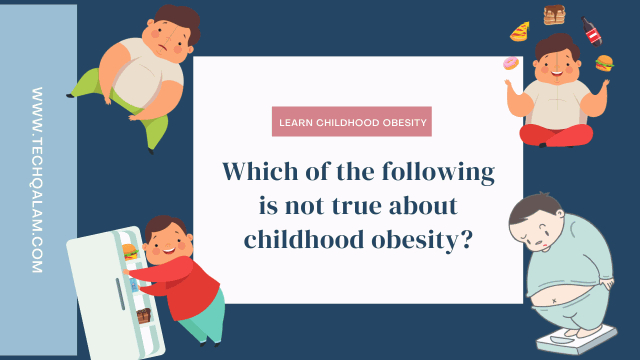Which of the following is not true about childhood obesity?
Childhood Obesity: Separating Fact from Fiction
Introduction
The rise in childhood obesity is a complex and pressing issue worldwide, impacting the health and well-being of millions of young individuals.

To address this concern effectively, it’s vital to unravel the intricate layers surrounding its causes, impacts, and misconceptions.
♦ Understanding Childhood Obesity
Definition and Causes
Childhood obesity is characterized by an excessive accumulation of body fat that can adversely affect a child’s health. While genetic predisposition plays a role, the onset and progression of obesity are influenced by various interconnected factors.
Behavioral elements such as dietary choices, physical activity levels, family habits, socioeconomic status, and environmental factors all contribute significantly.
Health Impacts
The repercussions of childhood obesity extend beyond physical health. It can trigger a cascade of health issues, including insulin resistance, type 2 diabetes, hypertension, sleep apnea, joint problems, and an increased risk of developing cardiovascular diseases early in life.
Additionally, the emotional toll cannot be underestimated, with obese children often experiencing bullying, social ostracization, and mental health challenges like depression and anxiety.

♦ Common Misconceptions about Childhood Obesity
While an unhealthy diet plays a substantial role, obesity is a multifaceted issue. Genetic factors, metabolism, hormonal imbalances, cultural influences, and accessibility to nutritious foods all contribute to the development of obesity in children.
Misconception 2: Childhood Obesity is Solely Genetic
Genetics can predispose individuals to obesity, but it’s not the sole determinant. Environmental factors, including the availability of healthy food options, physical activity opportunities, and family lifestyle choices, significantly influence a child’s weight.
Contrary to the belief that childhood obesity is a temporary phase, research suggests that it often persists into adulthood if not addressed early.
Overweight children are at a higher risk of becoming obese adults, facing a myriad of associated health complications.
Misconception 4: Only Physical Activity Can Combat Obesity
While physical activity is crucial, its effectiveness in combating obesity relies on a holistic approach. Dietary habits, portion control, nutritional education, and the quality of food consumed hold equal importance in managing and preventing childhood obesity.
♦ Facts about Childhood Obesity
The socioeconomic status of families significantly impacts a child’s risk of obesity. Limited access to affordable, nutritious foods in certain neighborhoods, known as food deserts, can contribute to poor dietary choices and higher obesity rates in those communities.
Fact 2: Psychological Impact on Children
Beyond physical health, childhood obesity can deeply affect a child’s mental and emotional well-being. The societal stigma surrounding weight can lead to low self-esteem, social withdrawal, and even more severe psychological conditions, adversely impacting their overall quality of life.
The pervasive advertising of high-calorie, low-nutrient foods coupled with sedentary behaviors promoted through various media platforms heavily influences children’s dietary preferences and activity levels.
This marketing landscape significantly contributes to the obesity epidemic among the younger population.

♦ Prevention and Management Strategies
Promoting balanced diets rich in fruits, vegetables, whole grains, and lean proteins is foundational to preventing and managing childhood obesity.
It’s essential to educate children and their families about proper nutrition and the importance of making healthier food choices.
Encouraging regular physical activity is crucial. Incorporating enjoyable and age-appropriate activities into a child’s routine fosters a positive relationship with exercise and helps maintain a healthy weight.
Creating supportive environments involving families, schools, communities, and policymakers is imperative. Initiatives like community gardens, access to recreational spaces, nutritional education programs, and policy changes promoting healthier foods in schools are instrumental in combating childhood obesity.
Exploring how hormonal factors, such as leptin and insulin resistance, contribute to the development and progression of obesity in children.
Discussing the impact of hormonal imbalances on appetite regulation and metabolic health, shedding light on the complexities of obesity beyond lifestyle factors.
Examining how cultural norms, societal attitudes, and the built environment affect children’s dietary habits, physical activity levels, and overall health Addressing how cultural perceptions of body image and societal pressures contribute to the prevalence of childhood obesity and exploring strategies to navigate these influences for healthier outcomes.

♦ Seeking Professional Help
Seeking guidance from healthcare professionals is essential. They can assess a child’s health, provide personalized plans, monitor progress, and address any underlying medical conditions contributing to obesity.
Emotional support through counseling and joining support groups can significantly benefit children and their families. It helps in addressing the emotional challenges associated with obesity, fostering motivation, and sustaining positive behavioral changes.
Conclusion
Childhood obesity is a multifaceted issue influenced by a myriad of factors beyond diet and exercise. Addressing misconceptions, understanding the multifaceted nature of this concern, and adopting a comprehensive approach involving various stakeholders are crucial in combating this prevalent health issue.
FAQs on Childhood Obesity
While it’s possible for children to grow into a healthier weight, without intervention, obesity often persists into adulthood.
Are genetic factors the primary cause of childhood obesity?
Genetic predisposition can contribute, but lifestyle choices and environmental factors play significant roles in the development of childhood obesity.
A balanced diet is essential, but incorporating physical activity and creating supportive environments are equally vital in preventing childhood obesity.
Society can play a pivotal role by advocating for policies that promote access to healthier foods, increase physical activity opportunities, and enhance nutritional education in schools.
Can emotional support help in managing childhood obesity?
Emotional support through counseling and support groups can positively impact a child’s motivation and adherence to healthier habits, aiding in the management of childhood obesity.
Get Access Now: https://bit.ly/k_ahm4







